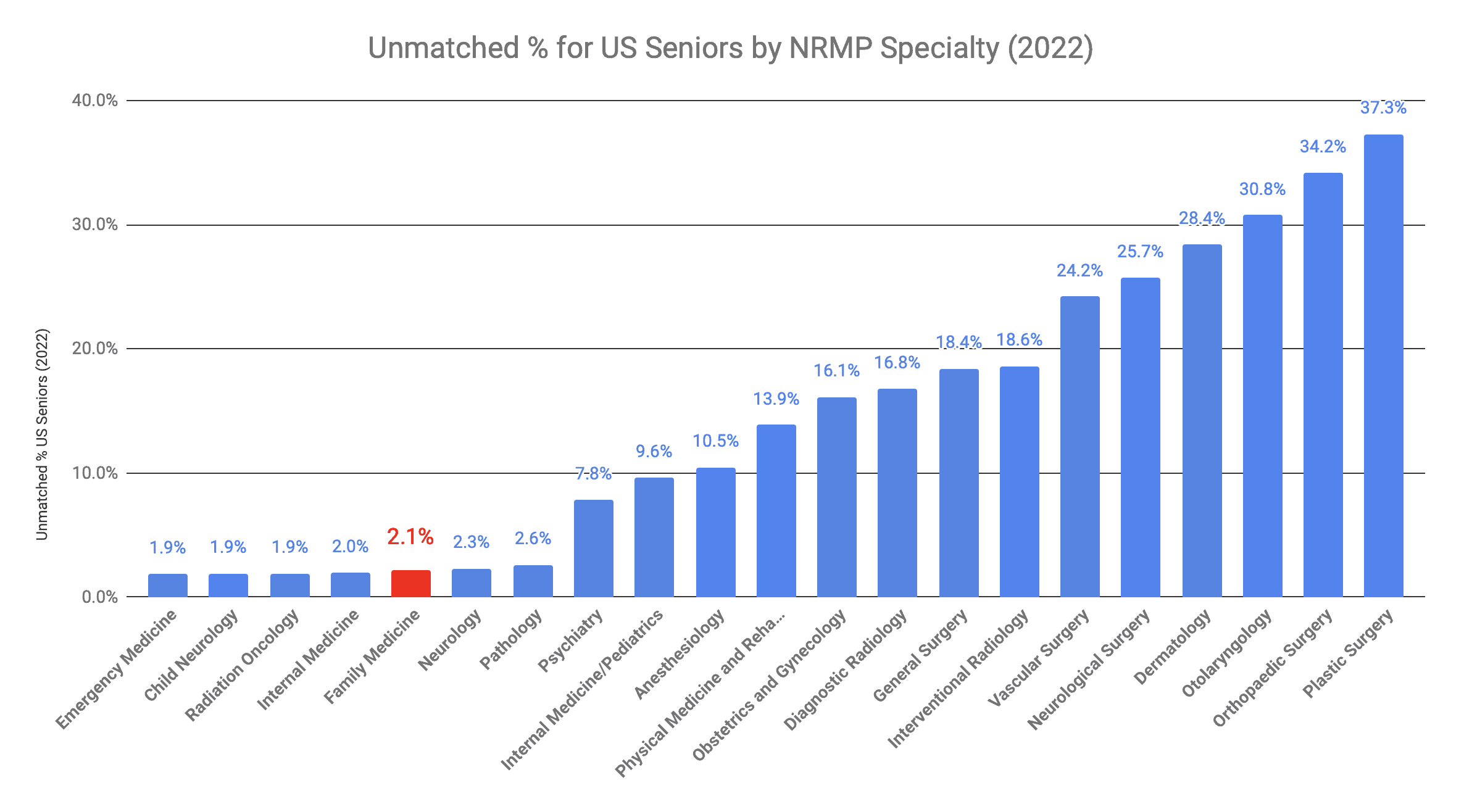
Summary:
- Family medicine physicians focus on the overall well-being of their patients but are ready to help when health problems arise.
- An integral part of family medicine is an ongoing, personal relationship between physician and doctor.
- Family medicine residency training is three years, with the option of fellowship training afterward.
- Going to a top medical school may help a bit. But, how you do on your USMLEs (Board) scores and in your medical school class ranking will matter more.
- Non-PhD degrees like MBAs and MPHs appear to have no advantage to becoming a family medicine physician (and maybe a slight disadvantage)
Table of Contents
What Are Family Medicine Physicians?
A family medicine physician plays a vital role in the medical field by diagnosing, treating, and providing preventative care to individuals and families throughout their lives. To fill this role, a family medicine physician must be knowledgeable about all aspects of the human body and its function.
Family medicine physicians provide optimal medical care to the individual by examining every aspect of their health rather than focusing on only one organ system at a time. In addition to diagnosing and treating ongoing illnesses, they try to prevent diseases before they occur through routine health screenings and lifestyle counseling while referring patients to a specialist when needed.
Is a Family Medicine Physician a Doctor?
Are family medicine physicians doctors? Of course! Just like other specialties, a family medicine physician has completed all the requirements to be a practicing doctor. This involves completing medical school and a three-year residency in family medicine. During training, family medicine physicians learn how to provide care for a wide range of conditions and recognize conditions that might require a referral to a specialist.
Family Medicine Physician vs. Internal Medicine Doctor: What’s the Difference?
A unique part of being a family medicine physician is being able to take care of a wide range of patients. From infants to the elderly, family medicine physician helps with the well-being of all their patients.
Internal medicine doctors, also called internists, care primarily for adults. To be able to treat children as well as adults, internists must have both internal medicine and pediatric training.
How Long Does It Take To Become a Family Medicine Physician?
Becoming a family medicine physician is one of the shorter paths to becoming a doctor. However, it still requires a great deal of time and energy. Though in the end, the results can be rewarding.
It takes a minimum of ten years after high school to become a family medicine physician. That includes four years of undergraduate education and four years of medical school, and three years of family medicine residency. Along the way, you will have to take various standardized exams, including the ACT, the MCAT, and the USMLE Step 1 and Step 2 CK.
Undergraduate (4 Years)
The first step to becoming a family medicine physician is completing an undergraduate program. This process starts by taking the SATs and doing well enough to be accepted into a college or university. Once accepted into an undergraduate program, you’ll have to complete a minimum of four years of academic coursework. While most people end up choosing a major in the sciences, that is not a requirement for medical school admission. The most important part is taking medical school prerequisite classes in subjects such as biology, chemistry, physics, English, and other general education courses.
Medical School (4 Years)
The next step is to take the MCAT. It is a standardized exam that measures your knowledge and skills in biology, chemistry, physics, and psychology. You will need to score well on the MCAT for medical school acceptance.
You will complete four years of academic and clinical training during medical school. This includes classes in anatomy, physiology, pharmacology, pathology, and other medical topics. You’ll also gain experience in clinical rotations at hospitals and other healthcare facilities.
Family Medicine Residency (3 Years)
After you have completed medical school, you will have to match into a family medicine residency. To do this, you’ll have to take the USMLE Step 1 and Step 2 CK exams. These exams measure your knowledge and skills in the areas of clinical medicine. Once you’ve passed these exams, you’ll be eligible to apply for residency.
Once you’ve matched into a family medicine residency, you’ll have to complete three years of clinical training to become a physician. During this training period, you’ll learn how to care for the wide range of patients you will have in your future practice. This ranges from infants to the elderly and from minor injuries to chronic illnesses.
Fellowship (Optional; Usually 1 Year)
After completing your residency, you may pursue further training in a specialized area of medicine. Completing a fellowship will allow you to gain expertise in a subspecialty of family medicine. Some of the options for fellowships include geriatrics, sports medicine, and palliative care. Most family medicine fellowships are about one year in length. This allows physicians to gain additional experience in a subspecialty of family medicine.
After Family Medicine Residency: Licensing + Board Certification
Upon completing your residency, you’ll be eligible to apply for a medical license which is a requirement for practice. You’ll also be able to take the Board Exam to become a board-certified family medicine physician. Taking and passing the family medicine boards is voluntary. Many employers will see this as important – or even necessary – for you to be employed as a family medicine physician.
How Competitive is it to Become a Family Medicine Physician?
Family medicine is one of the least competitive specialties in matching into a residency program. Each year, hopeful medical school graduates apply for a limited number of positions in their preferred specialty. The Match system, run by the National Resident Match Program (NRMP), pairs applicants with training programs based on their preferences.
But how competitive is family medicine in the US? To answer this question, it is important to look at the unmatched rates of US seniors by specialty. The unmatched rate refers to the percentage of US seniors who applied for a residency program in that specialty but did not get matched. It considers each applicant’s first-choice specialty. So, if you applied to a different specialty as a “backup” but didn’t match because you matched in your first choice, this wouldn’t be included. To learn more about how to maximize your chances at a dream residency through “The Match,” see this article.
In the 2022 Match, graduating US medical school seniors attending MD schools had a 2.1% unmatched rate to family medicine. This makes it one of the less competitive specialties.
For more on the competitiveness of family medicine relative to other medical specialties, see this article.
Family Medicine Annual Compensation
Family medicine physicians have an average annual salary of $255,000. However, this can vary dramatically based on practice setting, specialty training, and experience level.
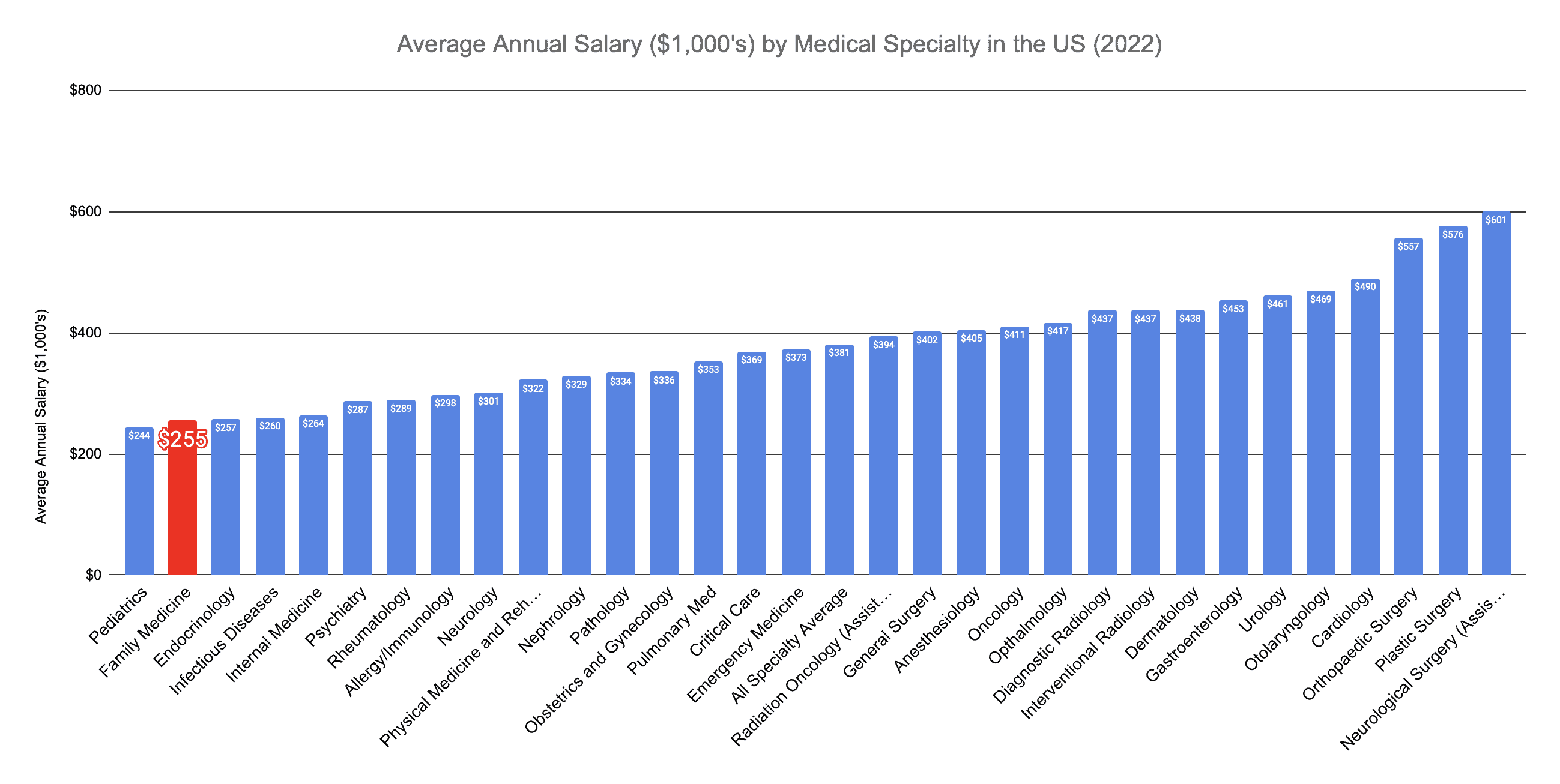
Family Medicine Doctors make $255,000 per year on average
How Much Do Family Medicine Physicians Make an Hour?
You may also be wondering, how much do family medicine physicians make per hour? And how is the balance between time inside vs. outside the hospital for the specialty?
While there is not perfect data, we’ve compiled data regarding hours and weeks worked. As well as the annual salary for various specialties, including family medicine.
Here are the data:
| Average Annual Salary | Average Hourly Salary | On-Call Schedule | Hours/Week | Avg Weeks Worked/Year | |
|---|---|---|---|---|---|
| Allergy/Immunology | $298,000.00 | $125.93 | 49.3 | ||
| Anesthesiology | $405,000.00 | $146.24 | Medium | 61 | 45.4 |
| Cardiology | $490,000.00 | $177.54 | 57.5 | ||
| Critical Care | $369,000.00 | $114.91 | 66.9 | ||
| Dermatology | $438,000.00 | $211.11 | Low | 45.4 | 45.7 |
| Diagnostic Radiology | $437,000.00 | $170.46 | Low | 58 | 44.2 |
| Emergency Medicine | $373,000.00 | $169.59 | Medium | 46.4 | 47.4 |
| Endocrinology | $257,000.00 | $110.40 | Medium | 48.5 | |
| Family Medicine | $255,000.00 | $101.85 | Medium | 52.6 | 47.6 |
| Gastroenterology | $453,000.00 | $168.53 | Medium | 56 | 47.7 |
| General Surgery | $402,000.00 | $141.88 | High | 59.4 | 47.7 |
| Infectious Diseases | $260,000.00 | $101.44 | High | 53.4 | |
| Internal Medicine | $264,000.00 | $100.81 | Medium | 54.9 | 47.7 |
| Interventional Radiology | $437,000.00 | ||||
| Nephrology | $329,000.00 | $122.40 | Medium | 56 | |
| Neurological Surgery (Assistant Prof. Median) | $600,500.00 | $214.96 | Medium | 58.2 | |
| Neurology | $301,000.00 | $129.09 | Medium | 50.8 | 45.9 |
| Obstetrics and Gynecology | $336,000.00 | $123.26 | Medium | 58 | 47 |
| Oncology | $411,000.00 | $143.43 | Low | 59.7 | |
| Opthalmology | $417,000.00 | $173.97 | Medium | 51 | 47 |
| Orthopaedic Surgery | $557,000.00 | $207.91 | Medium | 57 | 47 |
| Otolaryngology | $469,000.00 | $184.01 | High | 53.1 | 48 |
| Pathology | $334,000.00 | $147.74 | Low | 47.1 | |
| Pediatrics | $244,000.00 | $108.16 | Medium | 47 | 48 |
| Physical Medicine and Rehabilitation | $322,000.00 | $147.76 | 45.4 | ||
| Plastic Surgery | $576,000.00 | $230.77 | Medium | 52 | |
| Psychiatry | $287,000.00 | $131.04 | Low | 46.5 | 47.1 |
| Pulmonary Med | $353,000.00 | $119.77 | Medium | 61.4 | |
| Radiation Oncology (Assistant Prof. Median) | $393,734.00 | $158.36 | Low | 51.8 | |
| Rheumatology | $289,000.00 | $112.33 | 53.6 | ||
| Urology | $461,000.00 | $172.49 | High | 58.1 | 46 |
| Total Average | $381,233.35 | $147.44 | 53.9 |
And the estimated physician salary per hour by specialty (family medicine is highlighted in red):
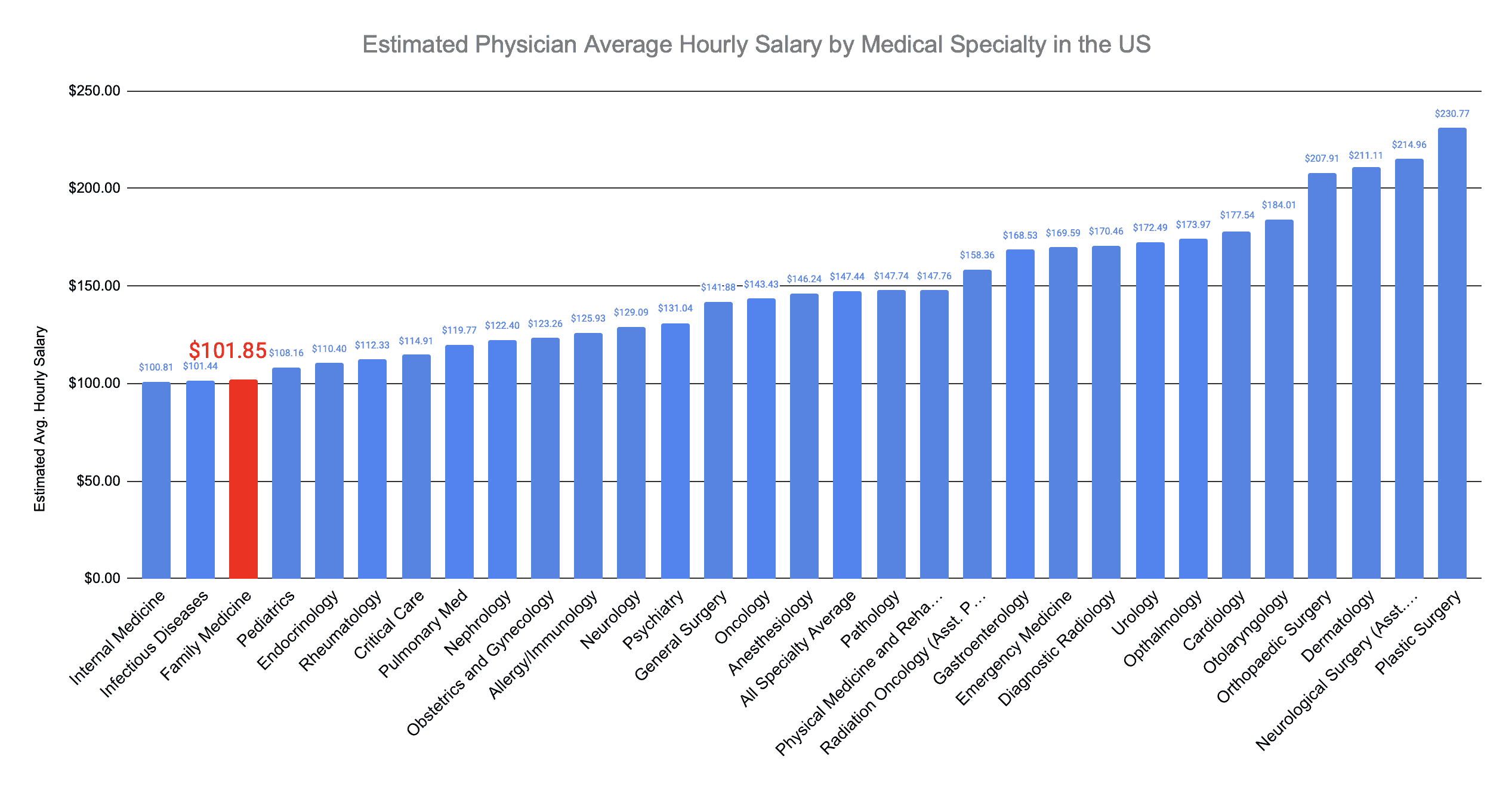
Family Medicine Doctors make $101 an hour on average
Note: when data were unavailable for weeks worked per year, 48 weeks was used as an estimate to calculate the estimated hourly salary.
Getting AOA (Med School Honors) Helps in Becoming a Family Medicine Physician
Medical school is one of the most challenging aspects of becoming a doctor. Many medical schools have established Alpha Omega Alpha (AOA) branches to recognize top students’ hard work and dedication.
Alpha Omega Alpha (AOA) is the medical school honors society for students who excel in their studies and demonstrate an exemplary commitment to professionalism and leadership. Each medical school may elect up to 20% of their graduating class to be inducted into AOA.
Induction into AOA is a prestigious honor that carries with it a variety of benefits. AOA members may be eligible for special scholarships and fellowships and can often receive priority consideration for residency positions.
The AOA advantage is particularly notable for the most competitive fields and/or residency programs. The 2022 Match data showed that the match rate for US medical school seniors with AOA membership was 2% greater than that of US seniors without AOA membership in family medicine. In other words, AOA membership provided a slight advantage to matching into a family medicine residency.
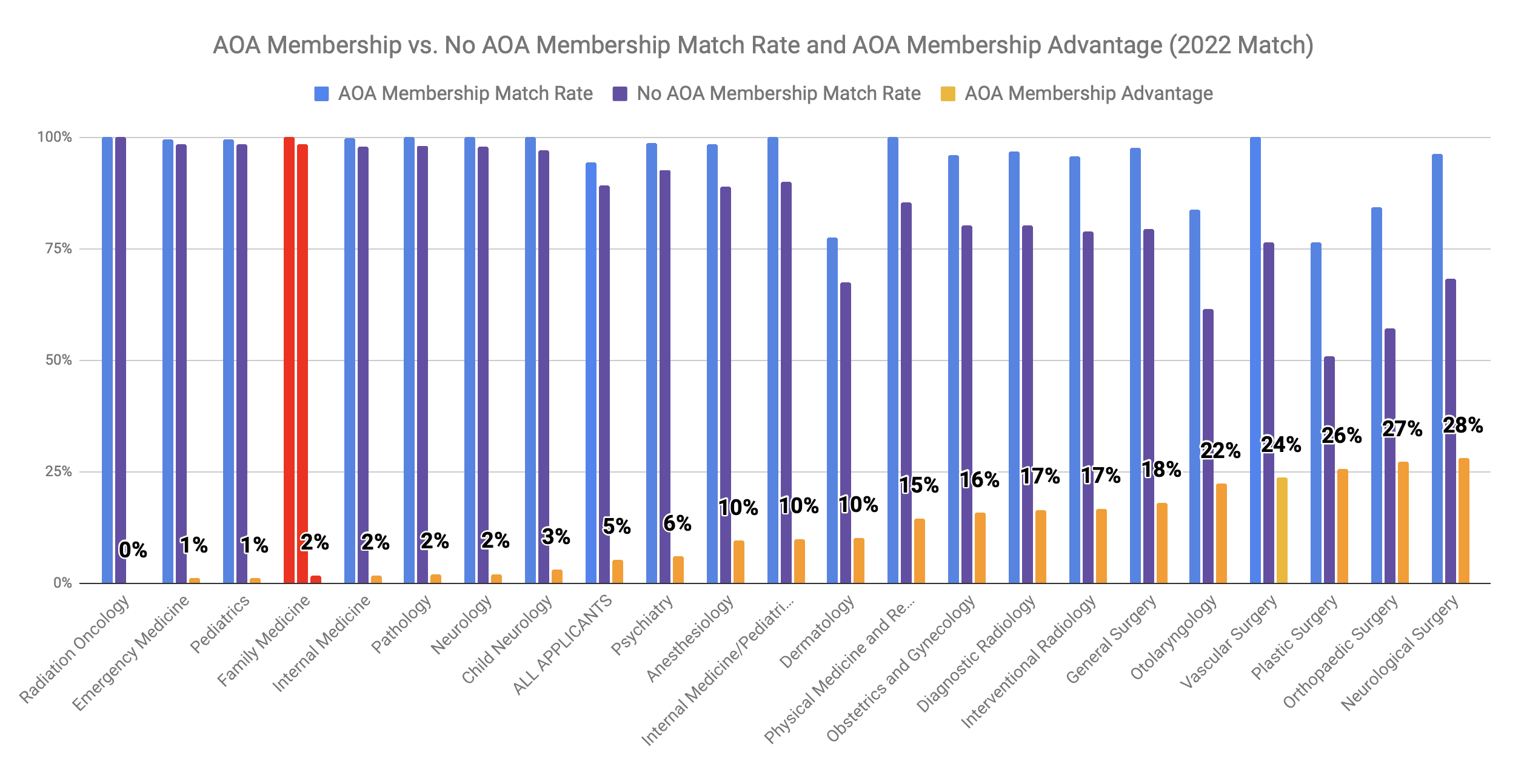
AOA membership correlated with a 2% match rate advantage for family medicine in the 2022 Match
See this article for more on AOA medical schools and the importance of class rank for matching.
Do You Need to Attend a Top School to Become a Family Medicine Physician?
When pursuing a career in family medicine, attending a top medical school can make a difference in matching into your desired specialty. According to a survey of program directors, over half of those surveyed reported considering applicants’ med school reputation when considering whom to interview, giving it an importance score of 3.7 out of 5.
Moreover, graduating from a school in the top 40 for NIH funding is associated with a 1% increase in the likelihood of matching into family medicine as a field. This is potentially because top medical schools have more resources and access to clinical experience, which can help prepare students for the rigors of the specialty.
That said, it is important to remember that the name of the school alone does not guarantee success in any field. While attending a top medical school may have advantages, it is ultimately up to the individual to make the most of the opportunities presented. And while there is an advantage to being from a more prestigious institution, one’s record at the school will matter much more, including things like USMLE scores, class rank, and letters of recommendation.
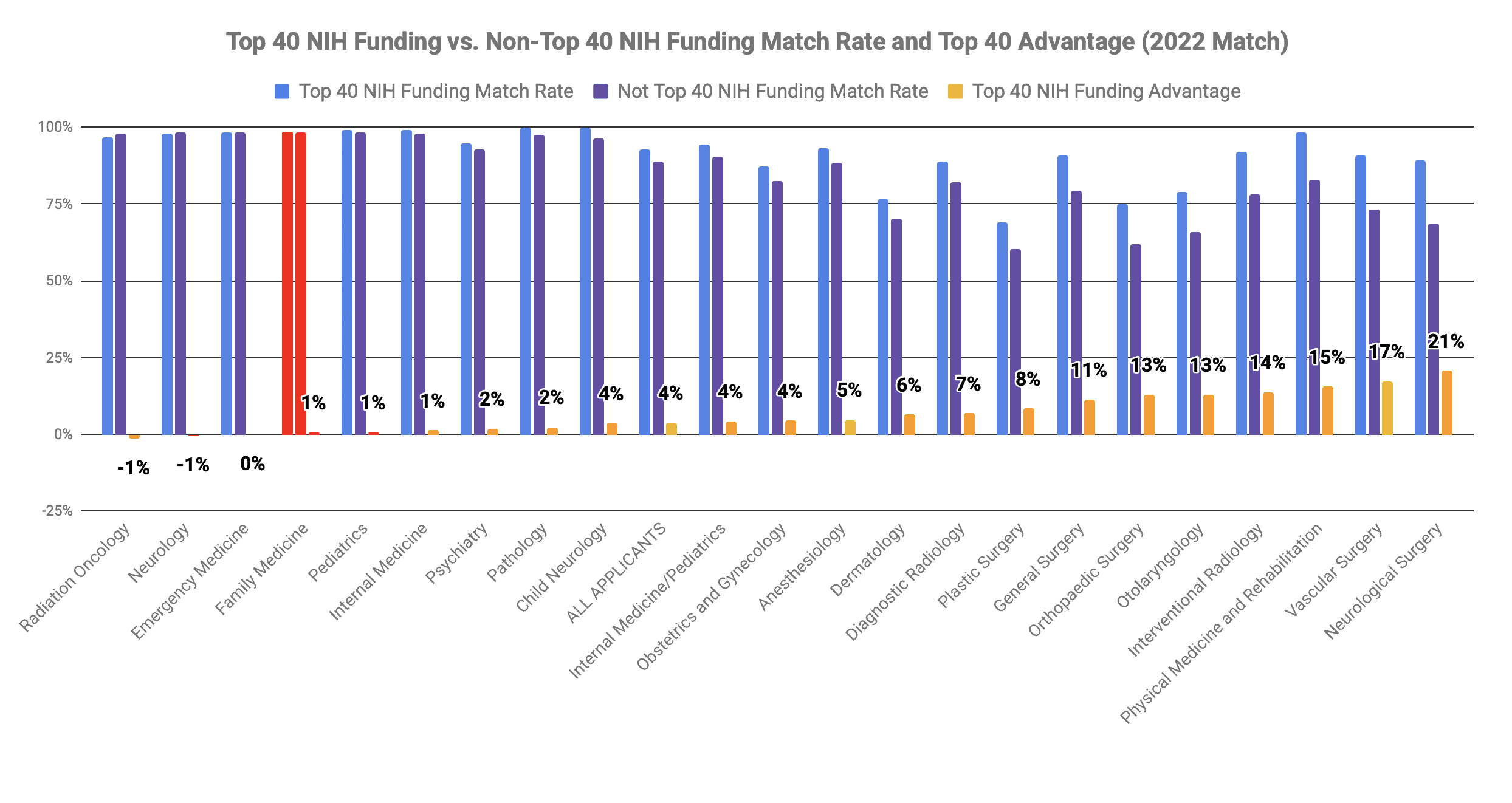
Graduating from a medical school ranked in the top 40 by NIH funding correlated with a 1% match rate advantage for family medicine in the 2022 Match
Does an MPH or MBA Help You Become a Family Medicine Physician?
Medical training is long and arduous. Remarkably, many students consider completing other degrees before, after, or even while pursuing their medical studies. Degrees such as Master of Public Health (MPH) and Master of Business Administration (MBA) may seem attractive to potential family medicine residents due to their additional qualifications. But do these additional degrees give applicants an edge in the residency application process?
The truth is that having an additional degree may not matter as much as one thinks. We crunched the numbers on the match rate for graduating students from MD schools for those with non-PhD other degrees vs. those that did not have a second degree. In family medicine, the match rate was 1% lower for those with degrees like an MPH or MBA. This implies that having a second degree that isn’t a Ph.D. doesn’t appear to help your chances of matching into family medicine and may even hurt them (slightly).
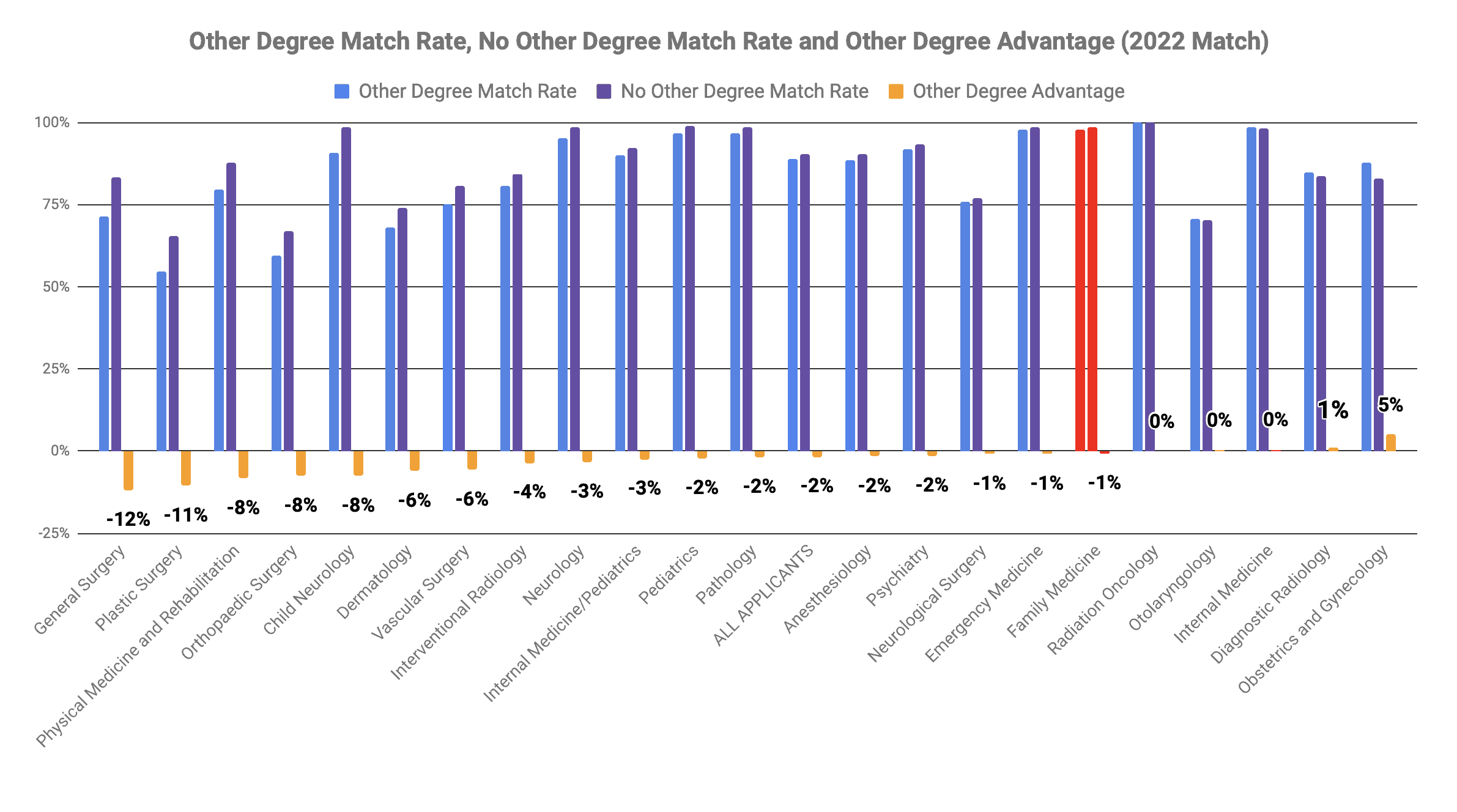
Having another degree like an MBA or MPH correlated with a -1% match rate disadvantage for family medicine in the 2022 Match
It’s important to note that this study only looked at the overall match rates of medical students with another degree. The data doesn’t look at the type of degree, the school it was obtained from, and the quality of the applicant’s experience and credentials.
Having a second degree could open up some additional career opportunities. For instance, having an MPH or MBA may prove beneficial for those looking to go into healthcare administration or research.
Concluding Thoughts
Becoming a family medicine physician is a challenging but rewarding career path. It is perfect for those who love a wide range of medical topics and patient care. With hard work, dedication, and a desire to help others, a family medicine physician can make a real difference in the world of healthcare.
Looking for a Family Medicine Residency Advisor?
Looking for a family medicine residency advisor? Want help writing your personal statement? Need effective strategies for interviewing? Do you have things on your application – e.g., low USMLE scores, failed USMLEs, no research, IMG status, or others – you need help overcoming?
Be sure to check out our Residency Advisor service.

